What You Need to Know About Event-Driven Architecture
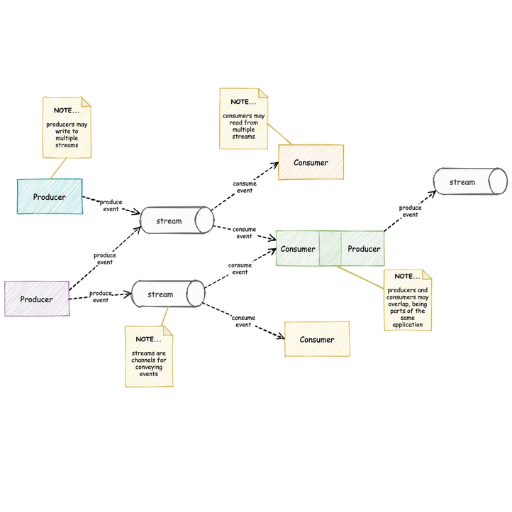
Event Driven Architecture, also known as EDA, has become increasingly captured interest in the last few years due to its responsiveness, scalability options, and real-time data processing. The goal of this article is to aid in understanding EDA architecture by emphasizing its principles while also comparing it with other traditional architectures. This article will detail the featured components of EDA, which include event producers, event channels, and event consumers which portraying importance based on their role in the framework. This article also covers where EDA marks its practicality, like in forming responsive UIs and strong microservices, EDA communications. After the readers are done reading the article, they will understand the importance of Event Driven Architecture as a choice for solving complex data issues that modern data-saturated applications face today.
What is Event-Driven Architecture?
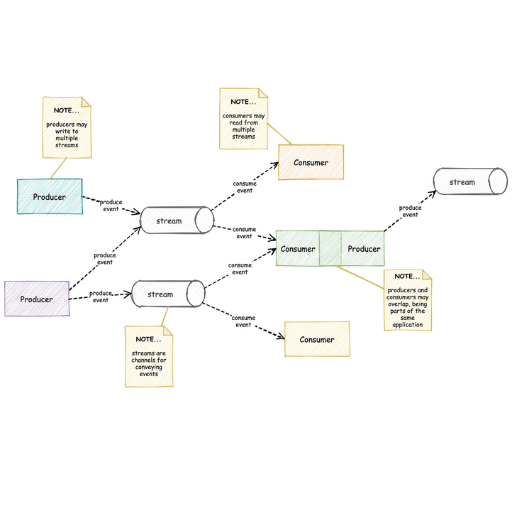
As a Shift in Software Design, EDA stands for Event Driven Architecture. Event-driven architecture is an approach to software design that focuses on the production, detection, and reaction to events. Some examples of these events can be data set notifications, user actions, or even system updates. Using event producer, channel, and event consumer, EDA ensures that update propagation and response time are dealt with promptly. Decoupling of components within the software permits advanced scaling, system flexibility, and better responsiveness, ideal for modern data-centric environments.
Understanding the Basics of Event-Driven Architecture
Event-driven architecture notes changes in a system as concept triggers, like user actions or system updates, as events. The components of EDA are event producers, which generate events, and event channels that transport these events to the event consumers to act on the generated events. This approach allows producers and consumers to be divorced, which means the system can easily adapt to modifications and scale. This flexibility enables producers and consumers to act like real-time applications, which is perfect for dynamic environments. Main advantages are responsiveness to change, the ability to scale efficiently, and to process large amounts of data with ease.
How Does EDA Differ from Traditional Architecture?
An Event Driven Architecture (ADA) is more different from classic architectures like request-driven and monolithic architectures in its method of interaction and communication. Asynchronous EDA Systems differ from traditional architectures, which are generally based on tightly coupled systems where all components interact synchronously. Take request-response for example: One of the systems directly calls another, and in turn, waits for a response. This creates bottlenecks and limits scalability.
Asynchronous, decoupled models where events are published and consumed create ADA. This accounts for effective scalability and real-time data streams. Unlike waiting for a direct answer, EDA enables components to act on occasions as they happen, leading to faster and more dynamic systems.
Some of the important points that can be thoroughly examined are:
- Communication Models:
- Traditional architecture refers to synchronous communication. For example, making REST API calls.
- EDA: Uses asynchronous communication over event queues or brokers, like Apache Kafka and RabbitMQ.
- Scalability:
- Traditional architecture: With direct dependencies between services, horizontal scalability is limited.
- EDA: Scalability with decoupled producers and consumers. This allows independent scaling.
- Data flow:
- Traditional architecture follows linear, sequential processing.
- In an EDA, the system utilizes non-linear and event-triggered processing.
- Latency:
- Synchronous waits lead to potentially higher latency for traditional systems.
- Lower latency is guaranteed for EDA due to the parallel processing of events.
These differences make EDA very effective for real-time data analysis, IoT applications, and use in environments with rapidly changing processes.
Key Components of an Event-Driven Architecture
In my opinion, the elements of event-driven architecture (EDA) comprise event producers, event brokers, and event consumers. Event Producers’ responsibilities include locating and creating events, which are then sent to the event brokers. An Event broker serves as a middleman and ensures that the events are properly distributed and the consumers are served with the appropriate event. On the receiving side, the event consumers work on processing these events and respond accordingly as needed by their purpose. Weaning the dependency on producers and consumers via a broker, EDA allows scale, flex, and instantaneous action in systems that change rapidly.
Why Use an Event-Driven Architecture?
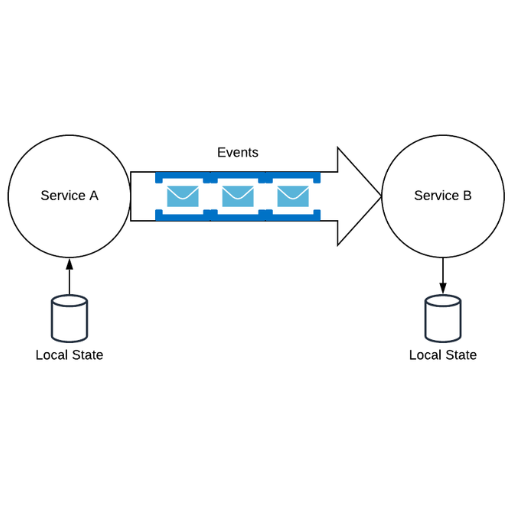
Event-Driven Architecture (EDA) provides several excellent benefits. In particular, it enables real-time data and event-driven processes, ensuring systems respond to changes and events. As discussed above, when demands but reaction speed is high, adding and removing components refers to greater scalability and flexibility, making it easier to monkey with shifts in requirements. Additionally, EDA better supports immoderate fault tolerance that is getting surprisingly high, ensuring the eclectic elements of the system do not affect the rest. Most suitable in conditions where a speedy reaction when merging with already existing divergence is required.
Benefits of Event-Driven Architecture
In my opinion, the best characteristics of Event-Driven Architecture (EDA) are its diverse range of applications, flexibility, resilience to faults, ease of managing workloads, and forgiving faults. The decoupling of components allows EDA systems to scale more easily with increased workloads. Flexibility leads to changes being more easily adopted without much effort. Moreover, EDA design ensures that individual processes can be executed independently, which avoids faults and enhances fault tolerance. This improves events that require a system to instantly adapt and combine processes and elements into one operating unit.
Scenarios for Use in Microservices
In my experience, event-driven architecture (EDA) is very useful within certain scenarios of microservices. One important example is tracking user behavior in e-commerce sites for processing personalized recommendations in real time. It also works well for integrating heterogeneous systems where asynchronous event messaging allows for communication between services without tight coupling. Automating workflows such as order processing is another example where events invoke particular microservices to execute specific tasks independently, increasing fault tolerance while improving scalability. EDA certainly improves efficiency and capability in ever-changing settings.
When to Use Event-Driven Architecture in Your System
When I think of implementing EDA into my system, the primary attributes I assess are flexibility, scalability, and requirements for real-time processing. Having real-time data processing needs is one of the major requirements that EDA caters to. Such a need exists in highly volatile data settings such as financial trading systems or IoT systems. I also make use of EDA when defining systems that must be separated for easier maintenance, such as microservices-based architectures. It is perfect for business events as well, such as order creation that requires autonomous actions like customer notification to be performed,d triggered through other events. With integration done using EDA, responsiveness and adaptability to changing demands and requirements are made easier across different services in a system.
How Does Event Processing Work?
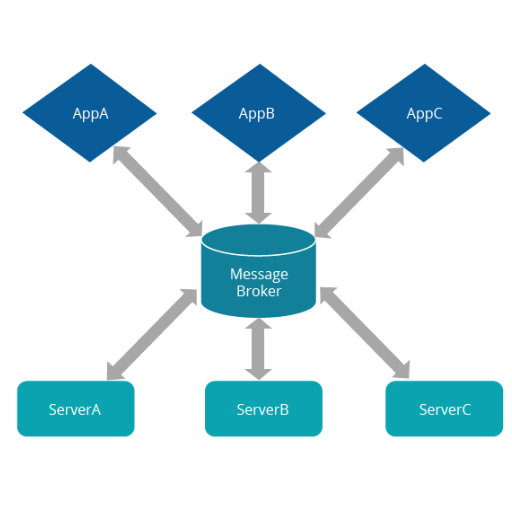
An event processing system functions by collecting, interpreting, and responding to events in real time or almost real time. An event takes place due to user actions, system state processes, or an external trigger; it is published to either an event stream or a message broker. These events are then consumed by services that are tailored or pre-programmed to process and react to them. This allows the whole system to work asynchronously as the components become more decoupled and can deal with the events individually. Coupled with the fact that responsiveness, flexibility, and scalability are achieved, makes it much better.
Different Types of Event Processing
This is what I consider to be the three most important types of event processing;
- Event Stream Processing: This involves a continuous and real-time handling of incoming events. It is typically used in cases of fraud detection, monitoring systems, and analytics. The expectation is to complete processing of an event and obtain insights, or execute required actions as the event happens, with no delays.
- Event Sourcing: An entire sequence of events is recorded, and serves as the authoritative source for the state of the system, which in turn stores. Instead of storing the present state directly, it is derived from replaying the events from the start. This is common in applications with strong audit trails and historical accuracy.
- Complex Event Processing (CEP): This is concerned with the search of patterns and relationships over multiple events over a period of time. This type is specifically useful for detecting sophisticated conditions stock market trends, breaches in network security, or in predictive maintenance.
With all approaches, there are strengths and specific purposes to attend to. The primary consideration is what the system under design is trying to achieve.
The Role of Event Brokers in Event Processing
As an essential link for the flow of data in event-driven systems, event brokers automate the flow of events between producers and consumers, such as applications. Event brokers aid in managing the relationship between event producers and consumers, which helps in enhancing reliability, scalability, and efficiency in distributed systems.
Event brokers come with the following key features:
- Event Routing: Event brokers do intelligent routing, which is the automation of distributing event data to the right consumers based on certain predefined topics, channels, or rules.
- Message Queuing and Delivery:
- Brokers ensure that events are placed in temporary storage, also known as queues, until the consumer system is ready to process them. Messages should also be delivered reliably.
- There are different delivery guarantees, such as:
- At-most-once guarantees – this indicates that the message will only be delivered once, however, it may be lost during failures.
- At least once guarantees – this will ensure that messages will always be delivered; however, if duplication occurs, a message may be redundant.
- Exactly-once delivery guarantees – this ensures that there are no duplicates therefore, the message is delivered only once.
- Protocol Support:
Brokers support different protocols such as AMQP, MQTT, and Kafka.
Event brokers can be used interchangeably with cloud native applications and older systems.
- Scalability And Performance:
Event brokers manage multiple streams of events simultaneously by using cluster load balancing.
Advanced brokers such as Apache Kafka can manage millions of low-latency events per second.
- Event Filtering and Transformation:
Filters are used to screen events by specific requirements before consumption.
Transforms modification or enrichment of content in an event downstream. For evaluating or configuring parameters for event brokers, the following technical aspects are notable:
- Latency: Represents the time taken by an event to move from a producer to a consumer. A typical range lies from milliseconds to several dozen milliseconds, depending on the broker.
- Throughput: Is the maximum number of events that can be processed within a specific time frame, measured in events per second. For instance, a broker is expected to handle peak loads (1 M+ events/sec) for high-performance brokers like Kafka.
- Fault Tolerance: These are dealt with by brokers through replication and redundancy means to ensure the service is sustainable during failures.
- Message Retention: Can be stored in RAM or as disk-based storage with configurable retention periods, like hours to days.
- Security:
- Authentication like OAuth, SASL, or TLS.
- Data encryption during transport and when at rest.
In modern systems where there is a growing need for real-time data processing and event-driven architectures, popular event brokers like Apache Kafka, RabbitMQ, Amazon SNS/SQS, and NATS are being used the fill specific gaps in throughput, latency, complexity, and required use case. Their role is incorporated in the framework.
Understanding Event Stream and Event Channel
An Event Stream is any continuous flow of streamable event data depicting events taking place over some time. These events are frozen in time and can be obtained from different places, such as user interactions, system activity logs, or IoT devices. In contrast, An Event Channel is the medium by which any event is sent from the producers (event sources) to the consumers (event processors). In simple terms, data streams are event data, while an event channel is the conveyance system.
When dealing with event streams and channels, a few basic factors ought to be looked at from a technical point of view:
- Throughput: The number of event streams produced and consumed within a specific period of time. Generally speaking, this is measured in events per second; for example, extreme systems like Apache Kafka strive with millions of events every second.
- Latency: The time taken for an event to move from the producer to the consumer. This period should be shorter in value for real-time processing.
- Retention Period: This should be set for a given period of time after which events are said to have expired within the system. This can be set to expire for minutes, hours, or even indefinitely using Kafka's adjustable retention time.
- Durability: This defines whether events are kept in a non-volatile storage location to protect data from being lost after failures occur.
- Scalability: An increase in the workload is handled by dynamically adding more producers, consumers, or brokers.
Having adequate knowledge about these terms allows one to efficiently build event-driven systems where the flow of data requires real-time processing and is key to the working of the system.
What are the Advantages of Event-Driven Architecture?
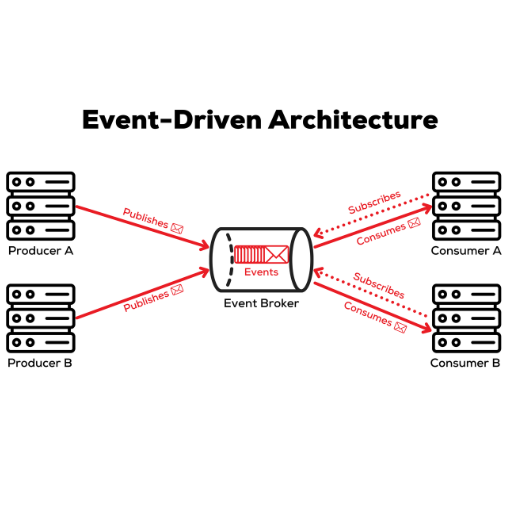
An event-driven architecture provides numerous benefits such as:
- Scalability: This allows systems to manage changeable workloads since components can scale independently using events.
- Flexibility: Asynchronous component communication allows the architecture to be modified for newly added features or changes.
- Real-Time Processing: Actions can be taken instantly, resulting in faster response times because events are processed immediately.
- Resilience: Because different components are decoupled, one system failure is less likely to bring down the whole system.
- Efficiency: During quiet periods, resources are conserved, and event-driven systems eliminate redundant expenditure.
Event-driven architecture encourages innovation by providing structures that are easy to adapt and responsive. Because of this, the approach is powerful for organizations that are looking to scale.
Exploring the Advantages of Event-Driven Architecture
With improved features and functions offered by Event-driven architecture (EDA), it has become a suitable choice for modern and distributed systems.
- Scalability: The decoupled components of EDA handle system dynamic workloads superbly, which enables EDA to scale horizontally on demand.
- Real-Time Capabilities: Events are captured and processed in real-time, allowing instantaneous data processing. These responsive systems benefit financial transactions, IoT systems, real-time user activity tracking, etc.
- Flexibility and Modularity: Components can be separately developed, tested, and deployed thanks to component decoupling, which EDA offers. This modularity improves system maintenance, updates, and reduces system downtime.
- Resilience: The fault tolerance is better, and the propagation of one component’s failure to other components in the system is less susceptible. Event brokers serve as buffers in the system, allowing continued operation during failures.
- Optimized Resource Use: EDA equips resources to avoid cost by not constantly running systems, and instead activating them when events are triggered.
Event-driven architecture is well-suited for organizations looking for agility and innovation, due to the complexity of the technology landscape.
How Loose Coupling Benefits Systems
Loose coupling makes it easier to scale, maintain, and increase a system's resiliency through the reduction of dependencies between components. This guarantees that changes or failures in one part do not significantly affect others. The following are its primary advantages:
- Scalability: One particular component can be scaled depending on the resource needs of its own, without affecting other components.
Example Parameter: Horizontal scaling of microservices to increase traffic handling.
- Maintainability: Components can be changed, updated, replaced, or debugged individually without needing an entire system overhaul, which decreases development complexity and downtime.
Example Parameter: Using versioned APIs allows for incremental changes without disrupting existing integrations.
- Resilience: Enhanced fault tolerance is achieved in systems containing loosely coupled components. Failures are likely to be contained to certain areas of the architecture and do not cascade throughout the whole system.
Example Parameter: Using event-driven systems with retry logic or circuit breakers.
- Flexibility: Integration of new technologies or third-party services are able to be easily done without significant disruption in operation, courtesy of loosely coupled architectures.
Example Parameter: Applying widely accepted formats for communications like JSON or REST/GraphQL.
These benefits allow the systems with loose coupling to remain efficient, reliable, and adaptable to changing requirements, expectations, or needs.
Real-Time Processing and Asynchronous Event Handling
Real-time processing is the approach used with the almost instantaneous handling and response to data in its raw form. This approach enables systems to react with essentially no delay. This is very important with online games, financial trading platforms, and IoT devices. Timing is of the utmost importance in these scenarios. Real-time systems are usually accomplished with event-driven architectures that implement asynchronous event processing for optimal resource usage and non-blocking actions.
Key Aspects For Optimized Effortless Processing and Event Handling:
- Event-Driven Architecture:
- Events are classified as actions and specific triggers that set them off.
- Technical/User Parameters:
- Use an event queuing system like RabbitMQ or Apache Kafka.
- Employ a message broker for guaranteed communication to prevent message loss.
- Preventing Event Blocking:
- No blocking I/O enables threads to wait without being blocked for numerous operations.
- Technical/User Parameters:
- Node.js offers frameworks that have content awaiting completion of/manageable tasks. For Python, asyncio offers libraries that open up uncompleted task waiting options.
- Best Awaited Resource Limitation:
- Setting maximum limits enables setting maximum acceptable resource consumption without hindering system responsiveness.
- Technical/User Parameters:
- Set the max limitation setting latency below or equal to 10ms for high priority applications.
- Employing CDNs or edge computing services.
- Automatic System Resource Supplementation:
- Solutions are required in an event surge or high command volume.
- Technical/User Parameters:
- Horizontal scaling can be deployed using cloud services such as AWS Lambda or Google Cloud Functions.
- Fault Tolerance:
- Design recovery methods to allow graceful degradation and facilitate system recovery during failures or interruptions.
- Technical Parameters:
- Implement a distributed architecture with checkpointing or replay logs, e.g., Apache Flink.
Integrating these principles and technologies allows real-time processing systems and asynchronous event-driven systems to achieve performance, scale, and fault tolerance appropriate for today's workloads, and enhanced reliability.
What are Some Event-Driven Architecture Use Cases?
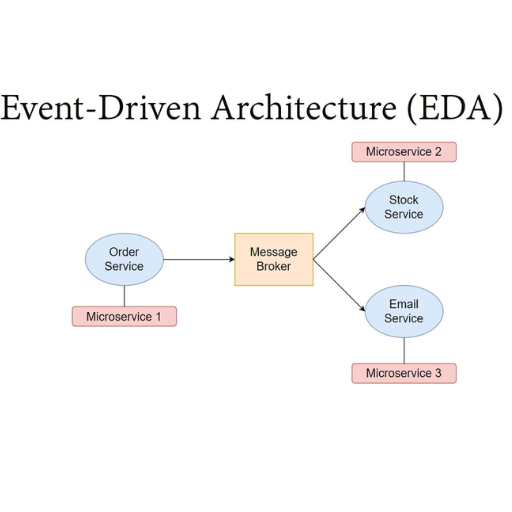
Scenarios that require responsiveness in real time, as well as responsiveness in scaling, are common in many industries and could be addressed easily using event-driven architecture. Some examples include:
- Retail and E-Commerce:
Real-time inventory updates, orders, and payment processing.
Personalized commendation based on user activity for better customer engagement.
- IoT and Smart Devices:
Real-time assistance in streaming data originated from sensors or wearables.
Automation of sentient surveillance, such as alert systems, passive changes tothe environment, or turning off.
- Finance and Banking:
Real-time transaction and event fraud detection.
Support of stock exchange services with real-time data and order execution.
- Media and Performing Arts:
Real-time advertisement event processors, performed based on content streaming processes.
Live broadcasting of events where adaptive bitrate streaming is progressively done based on network state.
- Well-being:
Real-time monitoring and controlling of medical devices or patient surveillance systems.
Reacting instantly in life-threatening situations.
The above-written examples clearly illustrate the ability of architectures that are event-driven to accommodate variety with efficiency across various domains.
Real-World Examples of Event-Driven Architecture
To allow systems to be responsive and to react on time to changes and events, event-driven architecture is used widely across several industries. For example, e-commerce sites like Amazon use event-driven systems to ensure actions taken by users, like inventory changes and order confirmations, are done in real time. In terms of media and entertainment, streaming allows users to watch videos seamlessly as it streams them at a notch higher quality depending on the strength of the network. Moreover, in healthcare, event-driven architectures enable real-time monitoring systems that respond to important modifications in patient data from wearables and other medical devices like monitoring phones. These all serve as examples to illustrate the benefits of building systems that even drive users. Such systems focus on adding to the efficiency and satisfaction of the user.
Industries Benefiting from Event-Driven Applications
In my opinion, integrating event-driven capabilities into applications enables systems to respond to events in real-time, which benefits the entire industry. For example, fraud detection in finance, as well as algorithmic trading, benefit greatly where fast-paced decisions are necessary. Dynamic inventory management is required in e-commerce for making personalized suggestions to clients. But not only ecommerce, the travel industry reaps the rewards by incorporating real-time fleet management and ride-hailing, enabling seamless send operations, notifications,s and updates. All these event-driven architectures gain the attention of many industries that strive towards advancement and optimization.
Innovative Event-Driven Integrations in Modern Systems
Integrations based on events are critical in modern systems by enabling real-time communication and responsiveness, which are essential in today’s digital ecosystems. Based on my knowledge and studies, these integrations help applications respond instantaneously to changes by processing purchases or updating inventories in real-time. Among other parameters, deployment of these integrations requires attention to latency, which ideally should be under 50ms for most real-time applications, throughput capacity, ensuring the system can sustain bursts of events, and scalability, which enables the infrastructure to adjust dynamically to the varying loads. Moreover, employing coverage of WebSocket or Kafka ensures proper event processing in IoT networks and financial systems, to mention but a few.
References
- AWS: Event-Driven Architecture - A detailed overview of EDA and its applications in modern microservices-based systems.
- Confluent: Event-Driven Architecture (EDA): A Complete Introduction - A comprehensive introduction to EDA, focusing on real-time event processing.
- Solace: The Ultimate Guide to Event-Driven Architecture Patterns - A guide to various EDA patterns, including communication and governance.
Frequently Asked Questions (FAQ)
Q: What is Event-Driven Architecture?
A: Event-Driven Architecture is an architectural pattern that relies on the production, detection, consumption, and reaction to events. It allows applications and systems to process events asynchronously and in real time, enabling more flexible and responsive interactions.
Q: When should you use Event-Driven Architecture?
A: You should use event-driven architecture when you need to build distributed systems that can react to events in real-time, handle complex event processing, or integrate multiple systems without waiting for a response from each action.
Q: What are the key components of Event-Driven Architecture?
A: The key components include the event producer, event consumer, event bus, and event message. These components work together to publish an event, process the event data, and notify the relevant parts of the system when an event occurs.
Q: How does an Event Bus function in this architecture?
A: An event bus is a central hub that routes event messages from event producers to event consumers. It allows different components of an event-driven system to communicate asynchronously and in real time, ensuring that event payloads reach their intended destinations without direct connections.
Q: Can you explain the difference between Simple Event Processing and Complex Event Processing?
A: Simple Event Processing handles individual events in isolation, processing them as they occur. Complex Event Processing, on the other hand, involves analyzing and correlating multiple events to detect patterns or conditions, enabling more sophisticated event stream processing and decision-making.
Q: What are some common use cases for Event-Driven Architecture?
A: Common use cases include real-time data processing, such as stock trading platforms, sensor data monitoring, user activity tracking, and any scenario where applications and systems must react to events promptly.
Q: How does Event-Driven Architecture handle incoming events asynchronously?
A: In an event-driven architecture, events are processed independently of the main program flow. This means that when an event occurs, the system can handle the event without having to wait for a response, allowing for more efficient and scalable processing of event streams.
Q: What role does an Event Mesh play in Event-Driven Architecture?
A: An event mesh is a network of event brokers that distribute event notifications across multiple systems and locations. It ensures that event data can be shared and accessed seamlessly across different parts of an organization, enhancing the flexibility and scalability of the architecture.
Q: How does this architecture enable real-time event processing?
A: This architecture enables real-time event processing by allowing systems to respond immediately to new events as they occur. This is achieved through the asynchronous processing of event messages, which ensures that event consumers can react without delay, facilitating timely decision-making and action.